A Tree Graph Showing How Our House of Representatives Works
The 117th U.S. Congress took office in Jan, with Democrats holding narrow majorities in the Firm and Senate.
Apart from its political makeup, the new Congress differs from prior ones in other ways, including its demographics. Here are 7 charts that testify how the demographic profile of Congress has changed over time, using historical data from CQ Curl Call, the Congressional Enquiry Service and other sources.
To determine the demographics of the 117th Congress, we pulled information from recently published Pew Inquiry Center analyses and other earlier piece of work. Because not all members of the 117th Congress were seated on January. iii, 2021, and considering some and so-filled seats are now empty or changed hands since that time, previously published data comes from several dates. For more than information on the methodology of previously published posts, please visit the original links, which are in the text of this post.
Data on the educational attainment of members of Congress includes the 532 voting members of the legislature as of March 3. Data is drawn from the U.S. Congress Biographical Directory and, when relevant, other official biographies and news reports.
All data points reverberate only voting members of Congress, except for the analysis of women in the legislature.
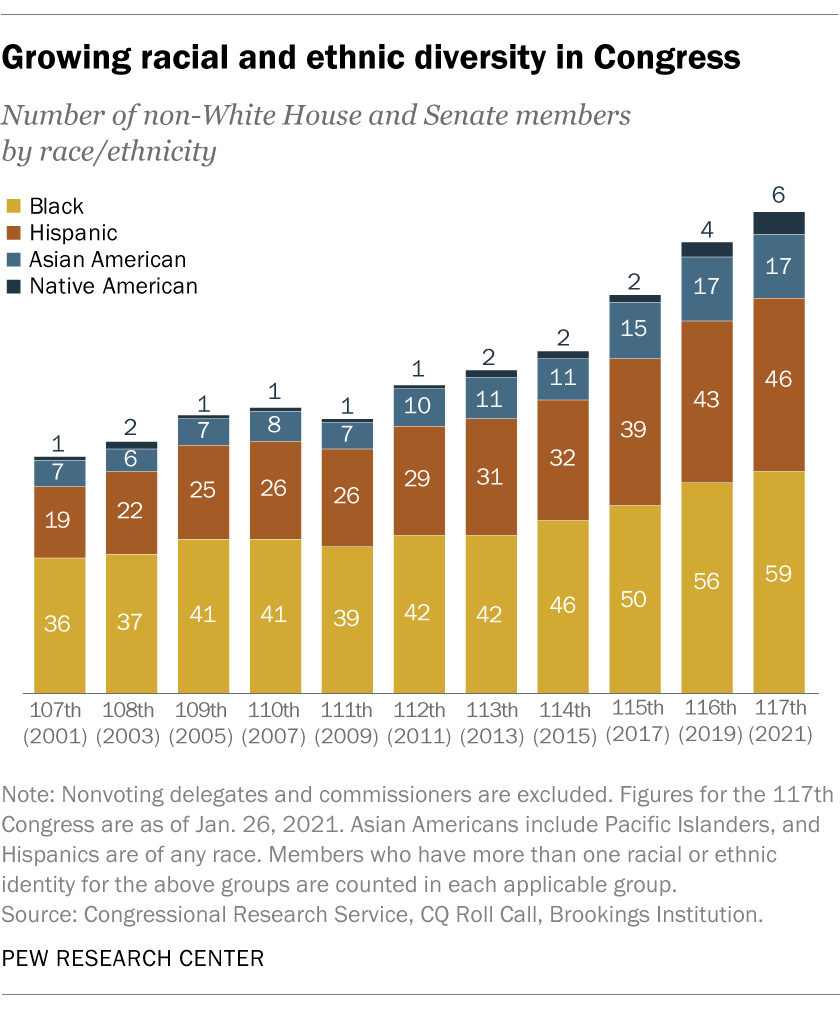
The electric current Congress is the most racially and ethnically various ever. Overall, 124 lawmakers identify as Black, Hispanic, Asian/Pacific Islander or Native American – making upwards 23% of Congress, including 26% of the Firm of Representatives and 11% of the Senate. By comparison, when the 79th Congress took role in 1945, non-White lawmakers represented just ane% of the Business firm and Senate.
Despite this growing racial and ethnic multifariousness, Congress remains less diverse than the nation as a whole: Not-Hispanic White Americans business relationship for 77% of voting members in the new Congress, considerably more their sixty% share of the U.S. population.
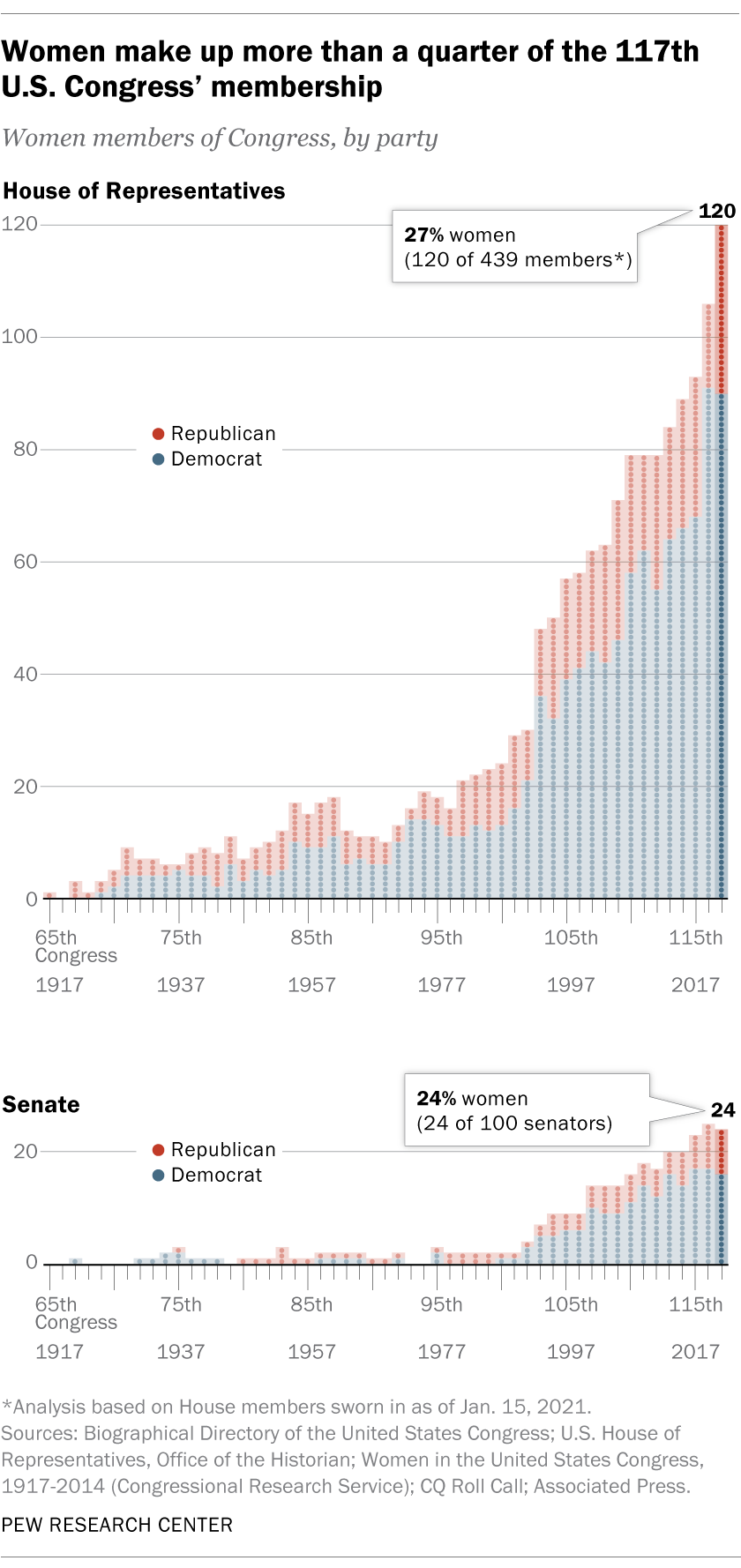
The number of women in Congress is at an all-time high.About a century later on Republican Jeannette Rankin of Montana became the kickoff adult female elected to Congress, there are 144 women in the national legislature, accounting for a tape 27% of all members across both chambers. (This includes six nonvoting House members who represent the District of Columbia and U.South. territories, iv of whom are women.)
A record 120 women are currently serving in the House, bookkeeping for 27% of the chamber'south total. There are 24 women in the Senate, one fewer than the tape number of seats they held in the final Congress. In four states – Minnesota, Nevada, New Hampshire and Washington – both senators are women, downwardly from half-dozen states in the previous Senate.
The House has seen slow but steady growth in the number of women members since the 1920s. Growth in the Senate has been slower: The Senate did not have more than three women serving at any point until the 102nd Congress, which began in 1991. And the share of women in Congress remains far below their share in the country as a whole (27% vs. 51%).
The number of Millennials and Gen Xers in Congress has risen slightly in recent years. In the current Congress, vii% of House members, or 31 lawmakers, are Millennials (born between 1981 and 1996), up from ane% in the 115th Congress. A third of House lawmakers, or 144 members, are Gen Ten (born from 1965 to 1980), up from 27% two Congresses earlier.
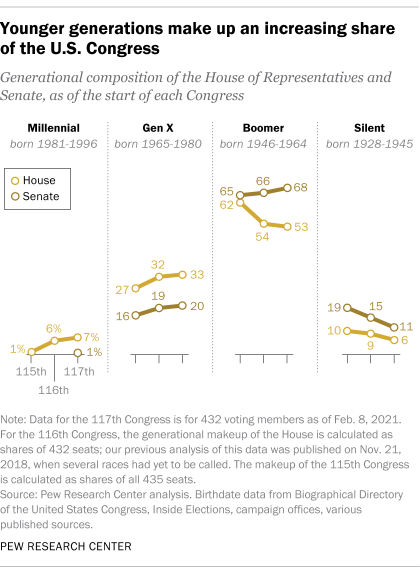
This year saw the swearing-in of the start Millennial senator: Democrat Jon Ossoff of Georgia. The number of Gen Ten senators has gradually ticked up from 16 in the 115th Congress to twenty this year.
While younger generations take increased their representation in Congress in recent years, older generations withal account for the majority of lawmakers across both chambers. Babe Boomers (born between 1946 and 1964) make up 53% of the Business firm's voting membership, in addition to 68 of the 100 senators.
The ranks of the Silent Generation (born between 1928 and 1945) take decreased in recent years, from 10%, or 42 members, at the start of the 115th Congress to six%, or 27 members, in the current Congress.
The share of immigrants in Congress has ticked upwards but remains well below historical highs.There are xviii foreign-built-in lawmakers in the 117th Congress, including 17 in the House and just 1 in the Senate: Mazie Hirono, a Hawaii Democrat who was born in Japan.
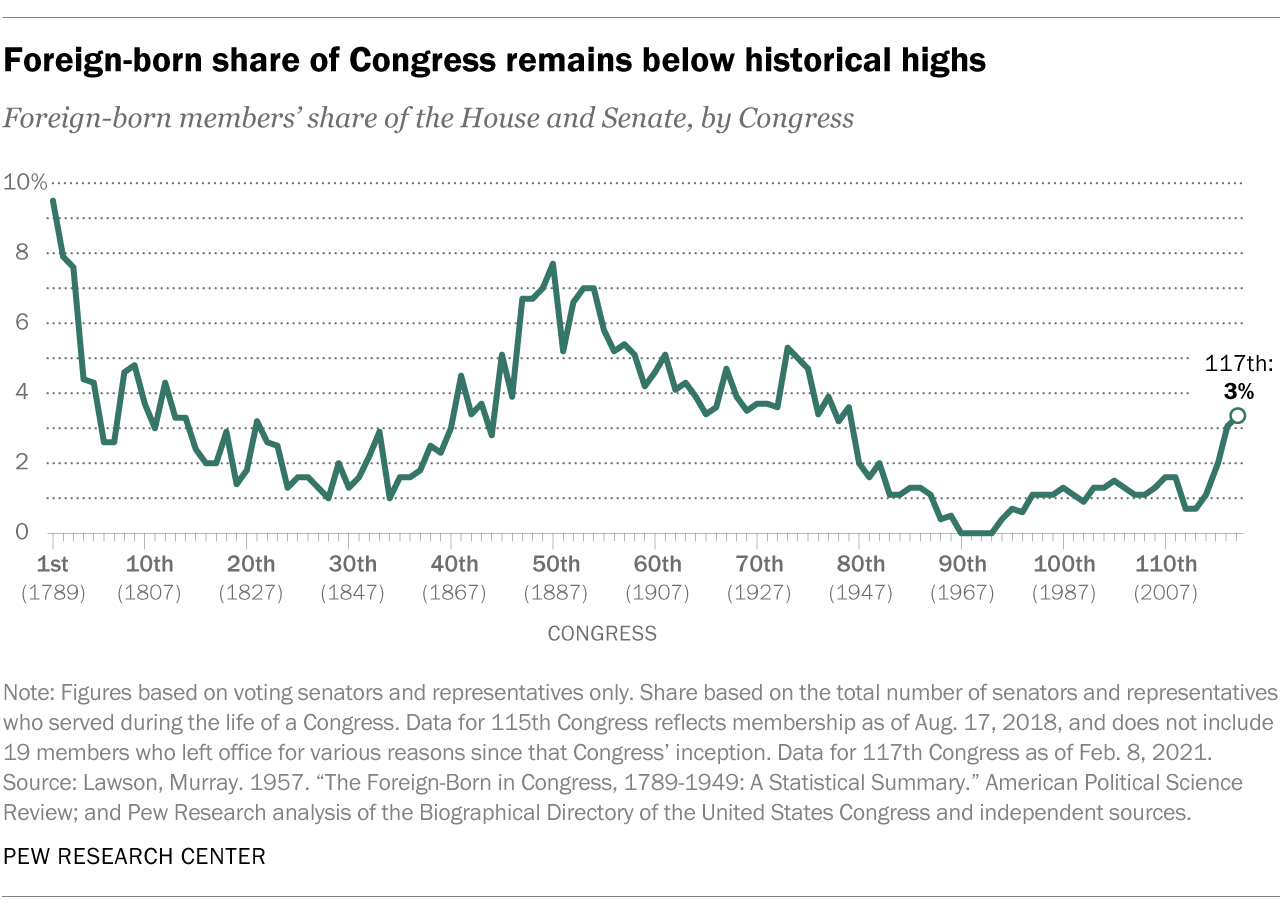
These lawmakers account for three% of legislators, slightly higher than the share in other recent Congresses but below the shares in much earlier Congresses. In the 50th Congress of 1887-89, for example, eight% of members were born away. The current share of foreign-born lawmakers in Congress is likewise far below the foreign-built-in share of the U.South. equally a whole, which was xiii.6% as of 2019.
While the number of foreign-built-in lawmakers in the current Congress is pocket-size, more than members have at least ane parent who was built-in in another country. Together, immigrants and the children of immigrants account for at to the lowest degree 14% of the new Congress, a slightly higher share than in the last Congress (13%).
Far fewer members of Congress now accept direct war machine feel than in the past. In the electric current Congress, 91 members served in the military at some betoken in their lives – the lowest number since at to the lowest degree World War Ii, according to Military Times. There are more twice as many Republican veterans (63) in the new Congress as Democrats (28). Equal shares of senators and representatives (17%) have served in the military.
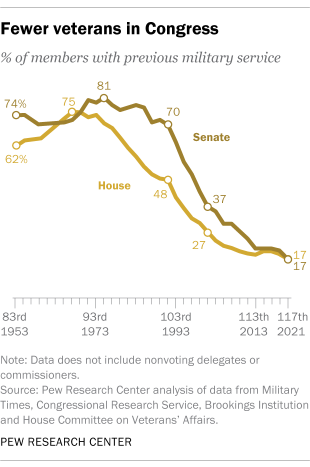
While the number and share of veterans in Congress overall have decreased, the newly elected freshman grade includes 15 such lawmakers.
Looking at the longer term, there has been a dramatic decrease in members of Congress with armed forces experience since the late 20th century. Betwixt 1965 and 1975, at least seventy% of lawmakers in each legislative bedroom had war machine experience. The share of members with war machine experience peaked at 75% in 1967 for the House and at 81% in 1975 for the Senate.
While relatively few members of Congress today have military experience, an fifty-fifty smaller share of Americans do. In 2018, well-nigh 7% of U.S. adults had military experience, downward from 18% in 1980, non long later the end of the military draft era.
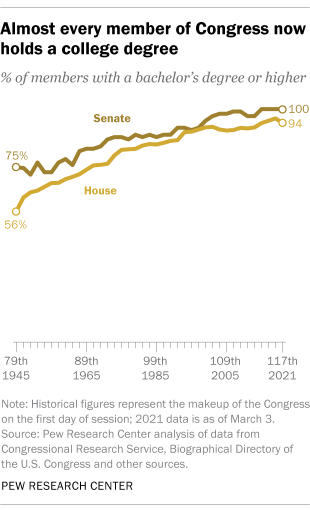
The vast majority of members of Congress take college degrees. The share of representatives and senators with a college degree has steadily increased over fourth dimension. In the 117th Congress, 94% of House members and all senators take a bachelor's caste or more instruction. Two-thirds of representatives and three-quarters of senators accept at least one graduate degree, likewise. In the 79th Congress (1945-47), by comparison, 56% of House members and 75% of senators had bachelor's degrees.
The educational attainment of Congress far outpaces that of the overall U.South. population. In 2019, around a third (36%) of American adults ages 25 and older said they had completed a bachelor's degree or more education, according to U.S. Demography Bureau data.
Congress has go slightly more religiously diverse over time.The current Congress includes the first two Muslim women ever to serve in the House and has the fewest Christians (468) in 12 Congresses analyzed past Pew Enquiry Center dating back to 1961. Despite this decline, Christians are still overrepresented in Congress in proportion to their share of the public: Nearly nine-in-10 congressional members are Christian (88%), compared with 65% of U.S. adults overall.
By dissimilarity, religious "nones" are underrepresented in Congress in comparing with the U.Southward. population. While 26% of Americans say they are atheist, agnostic or "nothing in particular," merely one lawmaker – Sen. Kyrsten Sinema, D-Ariz. – says she is religiously unaffiliated.
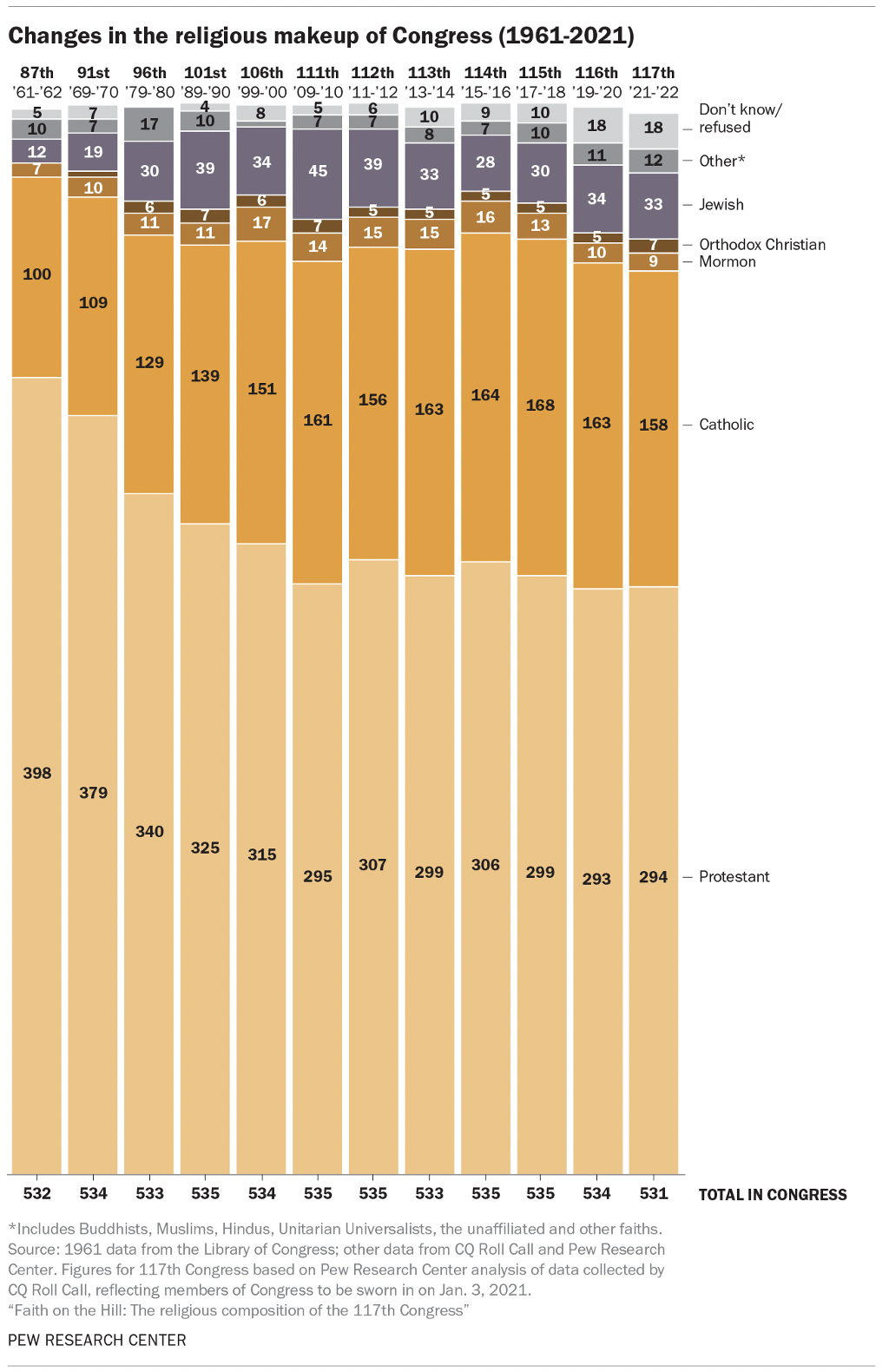
Note: This is an update to a mail originally published on Feb. 2, 2017.
Source: https://www.pewresearch.org/fact-tank/2021/03/10/the-changing-face-of-congress/
0 Response to "A Tree Graph Showing How Our House of Representatives Works"
Enviar um comentário